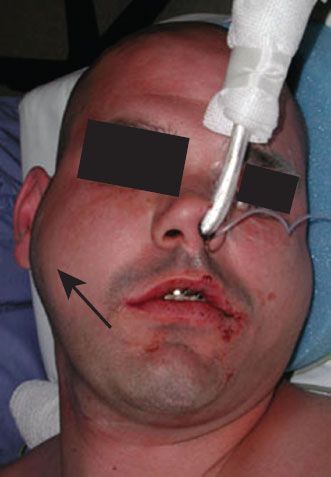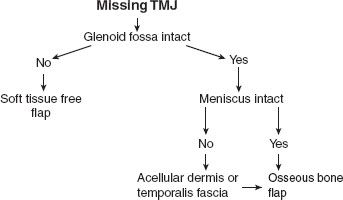Patients presenting with a malignant tumor originating from surrounding structures with secondary involvement of the TMJ may present with features similar to primary masses in the TMJ. More commonly, however, they will present with features of malignancy such as significant pain, otalgia, dysphagia, trismus, facial weakness, or infiltration of the skin.
Each patient’s past medical and surgical history should be reviewed in detail. The patient’s general health and his or her ability to tolerate a general anesthesia should be evaluated. Special attention should be given to any conditions that might compromise wound healing, such as diabetes or malnutrition. A history of peripheral vascular disease should also be investigated, as this may be pertinent in any patient in whom free tissue transfer is being considered.
PHYSICAL EXAMINATION
Any mass involving the head and neck requires a thorough evaluation. Suspicion of a mass involving the posterior mandible and TMJ may not be obvious. Attention to facial symmetry or unilateral facial swelling may reveal an underlying mass. The parotid gland should be palpated for discrete masses or lesions (Fig. 16.1). The TMJ should be assessed, noting dysfunction of the joint (clicking, locking, crepitus) or trismus. The skin should be examined for any suspicious cutaneous lesions. Examination of the ears should be performed with evaluation for unilateral middle ear effusion or decreased hearing. Any finding of unilateral effusion warrants assessment with flexible nasopharyngoscopy. The oral cavity and oropharynx should be examined looking for any suspicious lesions. Any residual dentition should also be evaluated. In addition, the oropharynx should be examined for deviation of the tonsil or lateral pharyngeal wall, as this may represent a mass arising from the parapharyngeal space. Evaluation of the cranial nerves should be performed as their involvement may indicate malignancy, perineural spread, or involvement of the skull base. Special attention should be given to the facial nerve and any weakness should be documented as this may alter surgical planning. Fixation of the skin to the mass or considerable pain suggest a malignant tumor.
INDICATIONS
Although multiple options exist for reconstruction of the TMJ, an understanding of when to use certain reconstructive techniques is critical to surgical success and patient outcome (Fig. 16.2). Perhaps most important in the decision-making process is assessment of the glenoid fossa. This can usually be evaluated preoperatively with the use of imaging studies but should also be assessed intraoperatively. If the glenoid fossa remains intact after completion of surgical ablation and confirmation of surgical margins, an osseous microvascular free flap can be used for reconstruction. Prior to inset of the free flap, the capsule of the glenoid fossa should be assessed, and if intact, the free flap may be inset. However, if no meniscus is present, soft tissue should be placed in the glenoid fossa. Multiple types of soft tissue have been used, all with some degree of success. Some examples include acellular dermis, free fascia, periosteum, or temporalis muscle. Absence of soft tissue between the end of an osseous free flap and the glenoid fossa results in bone on bone reconstruction, possibly resulting in ankylosis and subsequent trismus.
If surgical ablation to clear surgical margins requires resection of the lateral skull base, glenoid fossa, and condyle, reconstruction with an osseous microvascular flap is contraindicated. Instead, a soft tissue flap should be used to protect the brain from a prosthetic or bony condylar reconstruction. As described below, a flap of adequate bulk should be used to restore appropriate facial contour, and maxillomandibular fixation (MMF) will be required with gradual use of guiding elastics to allow occlusal guidance.
CONTRAINDICATIONS
There are no contraindications to reconstruction of the condyle using the fibula donor site unless the donor site lacks the three-vessel distal runoff required to harvest the flap.
PREOPERATIVE PLANNING
Any lesion of the head and neck found on clinical examination and in agreement with the patient’s history should be biopsied appropriately.
Since primary tumors of the TMJ are rare, the head and neck surgeon more commonly encounters tumors involving the TMJ as a result of locoregional spread. These tumors may originate from the parotid gland, skin, or oral cavity. Imaging starts with a CT scan of the neck with contrast (Fig. 16.3) as this provides good soft tissue detail and excellent detail regarding bony involvement. MRI may also be necessary to provide improved soft tissue detail, to demonstrate potential neural involvement, and to provide additional information regarding skull base involvement. If involvement of the lateral temporal bone is suggested on initial CT scan of the neck, a dedicated temporal bone CT with and without contrast should be ordered. In patients with residual dentition, a Panorex may be beneficial to assess the quality of the remaining teeth. Establishing a histopathologic diagnosis is critical in providing the correct treatment plan. Tumors of the oral cavity, parotid gland, or skin can often be directly evaluated and biopsied in the clinic. If not directly accessible, histopathologic evaluation can be obtained through fine needle aspiration biopsy (FNAB), with or without the aid of imaging modalities. If the diagnosis is still in question, open biopsy may be necessary.

FIGURE 16.3 A. CT scan demonstrating a mass in the right parotid involving the TMJ. B. CT scan demonstrating a primary tumor of the TMJ.
Primary tumors of the TMJ are less accessible to biopsy than are tumors of the parotid, oral cavity, or skin. These tumors are typically benign hyperplastic lesions of the TMJ or malignancy of some tissue derivative of the TMJ. Given the anatomic location, imaging is the least invasive method of evaluating these neoplasms. A review of the literature by Shintaku et al. suggests that a panoramic radiograph is a good screening study for hyperplastic lesions of the TMJ being 97% sensitive and 45% specific. CT imaging is 70% sensitive and 100% specific in defining bony abnormalities. MRI is useful in evaluating TMJ lesions as it also assesses the surrounding soft tissue and is able to differentiate benign and malignant bony TMJ tumors with 44% sensitivity and 95% specificity. Imaging modalities combining functional and morphologic modalities, such as single positron emission CT and positron emission tomography, demonstrate improved sensitivity in assessing hyperplastic conditions of the TMJ. Single positron emission CT has demonstrated 100% sensitivity and specificity when assessing a hyperplastic condyle. Although these imaging modalities aid in treatment planning, histopathologic evaluation may also be necessary. Given the anatomic location of the TMJ and lack of access, FNAB with the aid of CT may be employed, or open biopsy may be required.
The peroneal artery and its paired venae comitantes supply the fibula flap and its overlying skin paddle. Routinely, these vessels are ligated during flap harvest. In some patients, perfusion to the donor extremity is dependent on the integrity of these vessels. Peripheral arterial occlusive disease (PAOD) of the lower extremity may prevent the use of the fibula flap due to inadequate collateral circulation to the donor extremity and also render the pedicle vessels unusable. Vascular anomalies have also been reported whereby sacrifice of the peroneal vessels would result in ischemia in the donor leg, as the peroneal vessels are always present. Assessment of the vasculature of the lower extremity should be performed preoperatively to prevent possible complications in the donor site.
Stay updated, free articles. Join our Telegram channel

Full access? Get Clinical Tree




